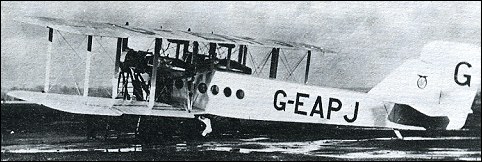 |
Handley Page W.81919 |  |
| PASSENGER | Virtual Aircraft Museum / United Kingdom / Handley Page |
 |
The Handley Page W.8B (three of which were originally operated by Handley Page Transport and then from 1924 by Imperial Airways on its London-Paris service) was a refinement of the original W.8. The latter flew for the first time on 2 December 1922 and had been modelled on the wartime Handley Page bombers. Twelve passenger seats were provided in two rows in a well-glazed cabin, while the pilot and co-pilot sat in an open cockpit in the nose of the fuselage. Unlike the W.8, which was powered by 335kW Napier Lion IB engines, the W.8Bs each had two 268kW Rolls-Royce Eagle VIII engines. The last W.8B was retired in 1932. In addition to the British-operated W.8Bs, one was built and exported to Belgium, where SABCA licence-built three more for Sabena. Handley Page also delivered a single example of the W.8E, with two 171kW Siddeley Puma and one nose-mounted 268kW Rolls-Royce Eagle IX engines. Eight were subsequently licence-built in Belgium. The final new W.8 version was the W.8F Hamilton. This was similar to the W.8E and in the words of the 1926 Jane's 'is a modification of the well-known W.8 type which has been designed specially with a view to producing a machine which shall be as nearly as it is possible to make it immune from involuntary landings caused by engine stoppage. These machines are to be used in the Belgian Congo, and it will readily be understood that absolute freedom from involuntary landings is of the very first importance for service in such a country. The machine itself is, except for the power plant, practically a standard W.8B. The nose of the fuselage ahead of the cabin has naturally been considerably modified. One of these machines in 1925 completed a flight from Brussels to the Belgian Congo, a distance of 11,000km, piloted by Lt Thieffry, of the Belgian Army, accompanied by Mecanicien De Bruycker.' It can be seen from this write-up that Jane's did not make a distinction between the W.8E and F. In fact Imperial Airways received only one W.8F, followed by one W.9A Hampstead and four W.10s (the last retired in 1933). The Hampstead was powered by three 287kW Siddeley Jaguar and then 335kW Bristol Jupiter VI engines and had a 5.31m long, 1.35m wide and 1.78m high passenger cabin for 14 persons. The W.10s each had two 335kWNapier Lion IIB engines and featured a new type of rudder, fitted with a balance of the inset-hinge type, instead of the earlier horn-balance arrangement. An interesting detail was the use of an entirely metallic structure for the engine mountings, replacing the usual wooden bearers.

|  COMPANY PROFILE | ||||||||||||||||||||||||||||||||||||||||||||||||
 |

|

Lo !
reply